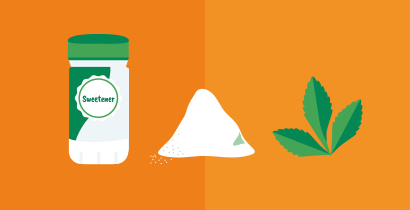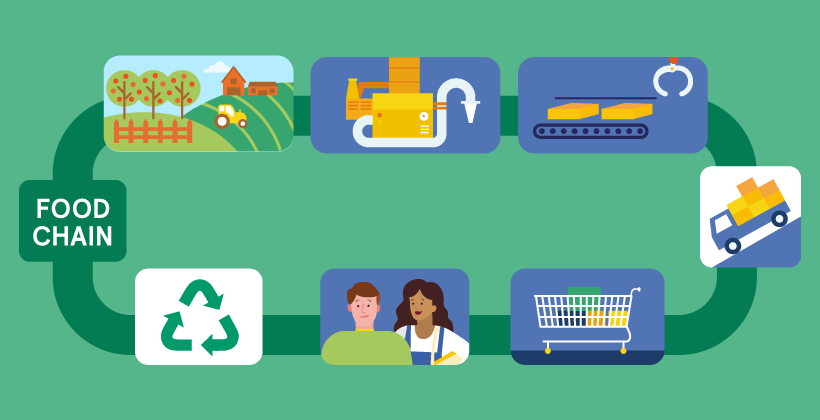What are food additives and how are they regulated in the EU?
Last Updated : 01 December 20211. Introduction
Despite modern-day associations, food additives have been used for centuries. Food preservation began when man first learned to safeguard food from one harvest to the next and by the salting and smoking of meat and fish. The Egyptians used colours and flavourings, and the Romans used saltpetre (potassium nitrate), spices and colours for preservation and to improve the appearance of foods. Cooks regularly use baking powder as a raising agent, thickeners for sauces and gravies, and colours, such as cochineal, to transform good-quality raw materials into foods that were safe, wholesome and enjoyable to eat.
Over the last 50 years, developments in food science and technology have led to the discovery of many new substances that can fulfil numerous functions in foods. These food additives are now readily available and include: emulsifiers in margarine, sweeteners in low-calorie products, a wide range of preservatives and antioxidants which slow product spoilage and rancidity whilst maintaining taste, and many others.
2. What are food additives and why are they used?
A food additive is defined as "any substance not normally consumed as a food in itself and not normally used as a characteristic ingredient of food whether or not it has nutritive value, the intentional addition of which to food for a technological purpose in the manufacture, processing, preparation, treatment, packaging, transport or storage of such food results, or may be reasonably expected to result, in it or its by-products becoming directly or indirectly a component of such foods" (Regulation (EC) No 1333/2008). Many food additives are naturally occurring chemicals and some are even essential nutrients (such as ascorbic acid, or Vitamin C). It is the fact that they are being added to food for a specific technological purpose that leads to these being classified as food additives.
Food additives play an important role in today's complex food supply. Whilst a shrinking proportion of the population is engaged in primary food production, consumers are demanding more variety, choice and convenience alongside higher standards of safety and wholesomeness at affordable prices. Meeting these consumer expectations can be achieved using modern food processing technologies which include the use of a variety of food additives.
Additives carry out a variety of useful functions which we often take for granted. Foods are subjected to many environmental conditions, such as temperature changes, oxidation and exposure to microbes, which can change their original composition. Food additives play a key role in maintaining the food qualities and characteristics that we expect, such as keeping food safe, wholesome and appealing from farm to fork. Food additives are very carefully regulated and the general criteria for their use is that they perform a useful purpose, are safe and that their use does not mislead the consumer.
3. How is the safety of food additives evaluated in Europe?
All food additives must have a demonstrated useful purpose and undergo a rigorous scientific safety evaluation before they can be approved for use. In the EU, the European Food Safety Authority’s (EFSA) Panel on Food additives and Flavourings is in charge of this task.
Safety assessments for food additives are based on the scientific review of all available toxicological data in both humans and animal models. From the available data, the maximum level of an additive where no toxic effect can be observed is determined. This is called the "no-observed-adverse-effect level" (NOAEL). The NOAEL is used to calculate an "Acceptable Daily Intake" (ADI) for each individual food additive. The ADI is the amount of a food additive that can be consumed daily over a lifetime without any adverse effect on health, and it includes a large safety margin.
To ensure people do not exceed the ADI by consuming too much of, or too many products containing a particular additive, EFSA and EU member states also look at how much of a food additive consumers are likely to be exposed to through their diets. Occasional intakes over the ADI are unlikely to cause any harm because of the built-in 100-fold safety margin. However, if the data shows that the ADI might be regularly exceeded by particular segments of the population, the European Commission would assess the need to review levels of that food additive in foods or reduce the range of foods in which the additive is permitted.
Read more about the process of food safety risk assessments here.
4. How are food additives regulated in Europe?
A true single market for food products could not exist without harmonised rules for authorisation and conditions for the use of additives. Since 2008, the EU Regulation (EC) 1333/2008 on food additives sets out the criteria by which additives are assessed and approved for use. This regulation harmonized the European legislation of all food additives, including sweeteners and colours which were previously covered by separate pieces of legislation, and lays out the procedures for authorization, conditions of use and rules for labelling. The list of authorised food additives and their specific conditions of use can be consulted in a database on the European Commission website. The database contains information on which foods each additive can be used in and any maximum levels for use. The purity required for these additives is laid down in a separate regulation defining specific purity criteria.
Part of EFSA’s role in evaluating the safety of food additives in the EU also includes the re-evaluation programme for food additives that have been authorised before January 2009. This process includes a review of the original scientific evaluation plus any new data that has been generated since then. If any safety concerns are identified, the European Commission and EU Member States are responsible for deciding whether regulatory action is needed, and implementing risk management measures.
5. What are the rules on labelling on food additives in the EU?
In the EU, food additives must be identified as ingredients of the foods in which they are used. The name or E number of the additive (e.g. citric acid or E 330) must be listed on the labels of food products as well as information about the function that the additive performs in the food (i.e. why it is used: e.g. preservative). Some common additives include: colours, preservatives, antioxidants, emulsifiers, stabilisers, thickeners, and sweeteners. These are each discussed in more detail below.
6. What is an E-number?
An E-number is assigned to each individual food additive and signifies approval of an additive by the EU. To obtain an E-number, the additive must have been fully evaluated for safety by EFSA. The E-number system serves as a simple and convenient way to label permitted additives across the range of languages in the European Union.
7. Do food additives cause hyperactivity?
In the 1970s, some researchers suggested that changes in diet had coincided with a rise in the number of children with behaviour problems. The idea that food additives, and food colours in particular, could be linked to hyperactivity generated much interest and considerable controversy.
In 2007, a study by researchers at the University of Southampton linked increased levels of hyperactivity in young children with consuming mixtures of some artificial food colours and the preservative sodium benzoate. The results of the Southampton study show that when the children were given the drinks containing the test mixtures, in some cases their behaviour was recorded as significantly more hyperactive.
In 2008, the European Food Safety Authority (EFSA) evaluated the study against the background of previous studies, going back to the 1970s, on the effect of food additives on behaviour and acknowledged that it was the largest study carried out on a suggested link between food additives and hyperactivity in the general population. The scientific assessment panel was assisted by experts from the fields of behaviour, child psychiatry, allergy and statistics. The panel noted that the majority of the previous studies looked at groups of children already described as hyperactive and concluded that these studies were therefore not representative of the general population.
The EFSA concluded that there was limited evidence that the mixtures of additives tested had an effect on the activity and attention of some children. Although the findings from the study could be relevant for specific individuals showing sensitivity to food additives in general or to food colours in particular, it was found not to be possible to assess how widespread such sensitivity may be in the general population.
Professor of Psychology, Jim Stevenson, who led the research noted 'However parents should not think that simply taking these additives out of food will prevent all hyperactive disorders. We know that many other influences are at work but this at least is one a child can avoid.'
8. Can food additives cause allergies or other adverse health effects?
There has been much public concern that additives cause adverse reactions although careful investigations show that this is often based on misconception rather than on identifiable adverse reactions. While food additives pose no problems for most people, a small number of people with specific allergies may be sensitive to certain food additives. It appears that where food additives have an adverse effect, they exacerbate a pre-existing condition rather than induce it. These adverse reactions, which are rarely allergic, and the foods or food components responsible, should be validated by a health professional or dietician to ensure that unnecessary dietary restrictions are not imposed. As all food additives are clearly labelled, so those with specific sensitivities can readily avoid any that may pose problems.
Among the food additives reported to cause adverse reactions are:
Colours
Reactions to tartrazine (E 102, a yellow food colour) and carmine (E 120 or red cochinille) have been reported occasionally in sensitive individuals. Symptoms include skin rashes, nasal congestion and hives, although the incidence is very low (estimated to be 1-2 persons per 10,000) and very rare. IgE-mediated allergic reactions have been reported for carmine. Tartrazine has also been reported to cause asthma in sensitive individuals although the incidence is extremely low.
Sulphites
One group of additives that can cause problems in sensitive individuals is the sulfiting agents. This group includes several inorganic sulphite additives (E 220-228), including sodium sulphite, potassium bisulphite and metabisulphite containing sulphur dioxide (SO2). These preservatives are used to control microbial growth in fermented beverages and they have been widely used in wines, beers and fruit products for over 2000 years. In sensitive (asthmatic) individuals, sulphites may trigger asthma characterised by breathing difficulties, shortness of breath, wheezing and coughing.
Glutamic acid and glutamates
MSG is made up of sodium and glutamic acid. Glutamic acid is an amino acid found naturally in high protein foods such as meats and dairy products like Camembert cheese. MSG is also a flavour enhancer used in prepared meals, some Chinese food, certain sauces and soups. MSG has been associated with a variety of side effects including headaches and body tingling. In 2017, after a re-evaluation of their safety, EFSA established a safe intake level for glutamic acid and glutamates, and concluded that some population groups may exceed this level of consumption. They recommended that the European Commission and EU member states review the maximum permitted levels of these additives in foods, a process which is currently ongoing.
Titanium dioxide
Titanium dioxide a food colour that is used in a range of foods such as bakery products, soups, sauces and sandwich spreads. In 2021, EFSA updated its safety assessment of titanium dioxide, and based on their evaluation of all available data, including new evidence that has been produced since their previous assessment. They concluded that they no longer consider titanium dioxide safe as a food additive, as they were unable to rule out concerns with regards to genotoxicity. The European Commission and EU Members states were informed of this conclusion and as a result they have voted to ban the use of titanium dioxide as a food additives in Europe. The ban is expected to come into force in early 2022.
9. What food additives are used in Europe?
Find a list of the categories of food additive currently used in the EU, here.
References
- Regulation (EC) No 1333/2008 of the European Parliament and of the Council of 16 December 2008 establishing a common authorisation procedure for food additives, food enzymes and food flavourings
- European Commission Food Additives Database
- EFSA (2009) Scientific Opinion on the re-evaluation Tartrazine (E 102), EFSA Journal, 7(11):1331
- EFSA (2015), Scientific Opinion on the re-evaluation of cochineal, carminic acid, carmines (E 120) as a food additive, EFSA Journal, 13(11):4288
- EFSA (2016) Scientific Opinion on the re-evaluation of sulfur dioxide (E 220), sodium sulfite (E 221), sodium bisulfite (E 222), sodium metabisulfite (E 223), potassium metabisulfite (E 224), calcium sulfite (E 226), calcium bisulfite (E 227) and potassium
- EFSA (2017) Re-evaluation of glutamic acid (E 620), sodium glutamate (E 621), potassium glutamate (E 622), calcium glutamate (E 623), ammonium glutamate (E 624) and magnesium glutamate (E 625) as food additives, EFSA Journal, 15(7):4910
- EFSA (2021) Safety assessment of titanium dioxide (E171) as a food additive, EFSA Journal, 19(5):6585



